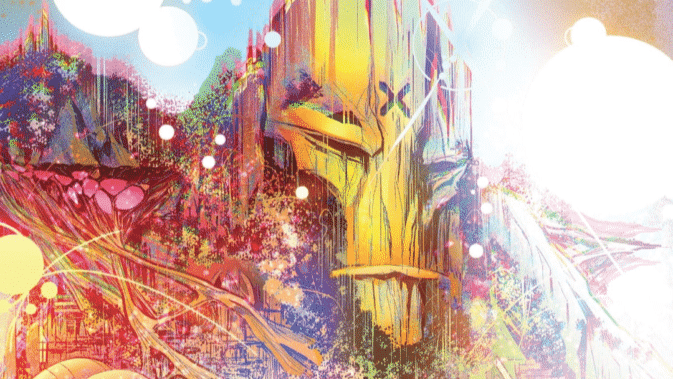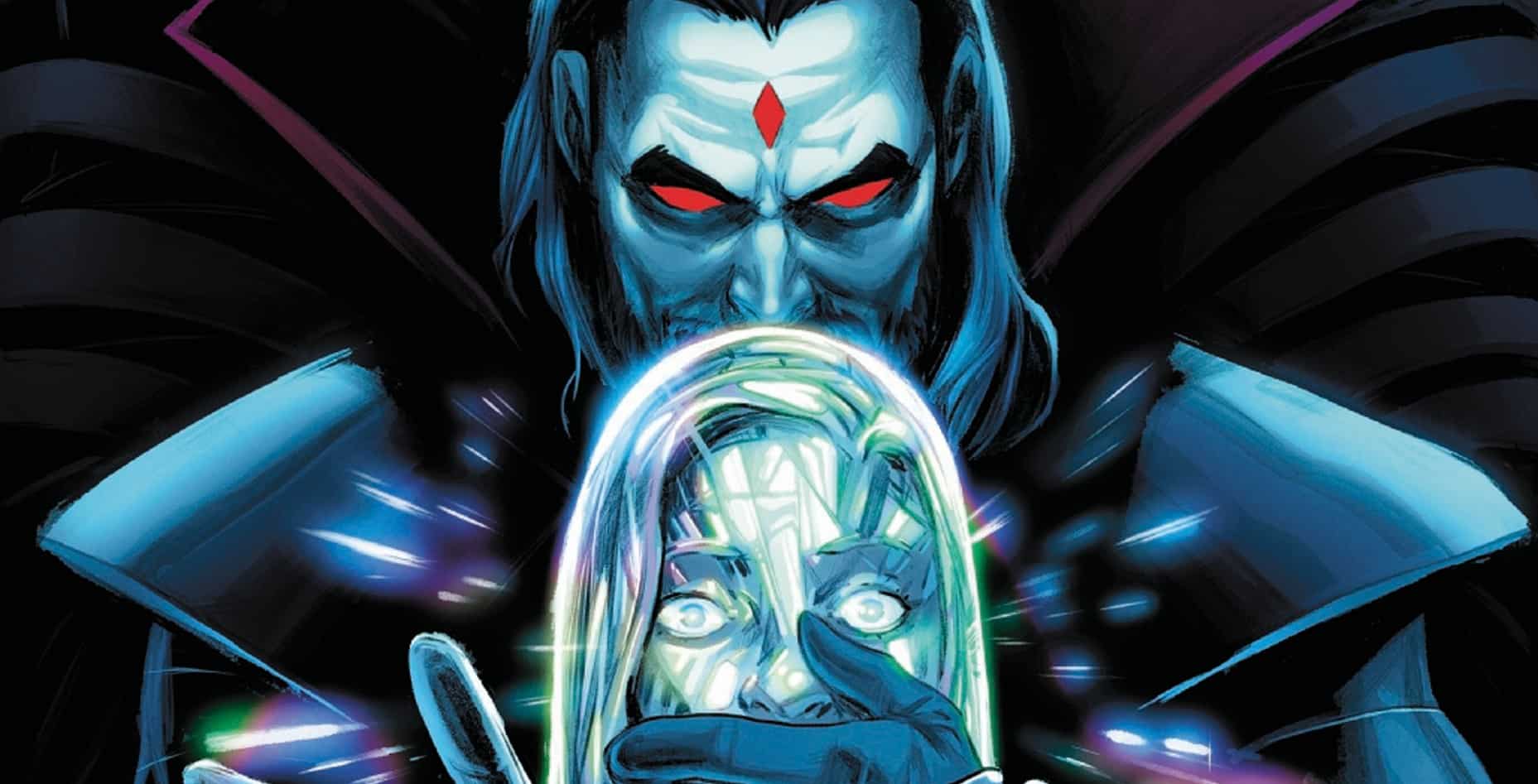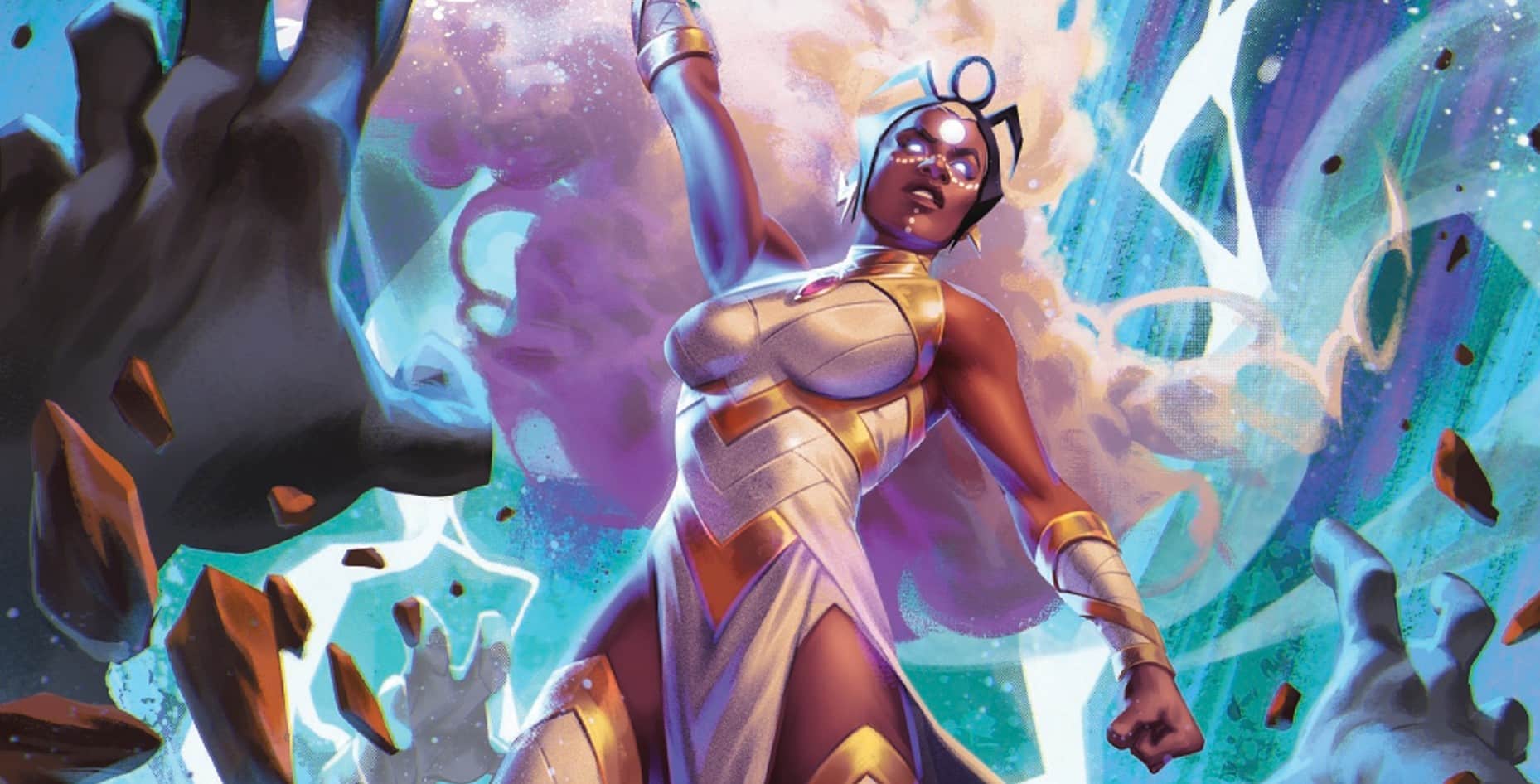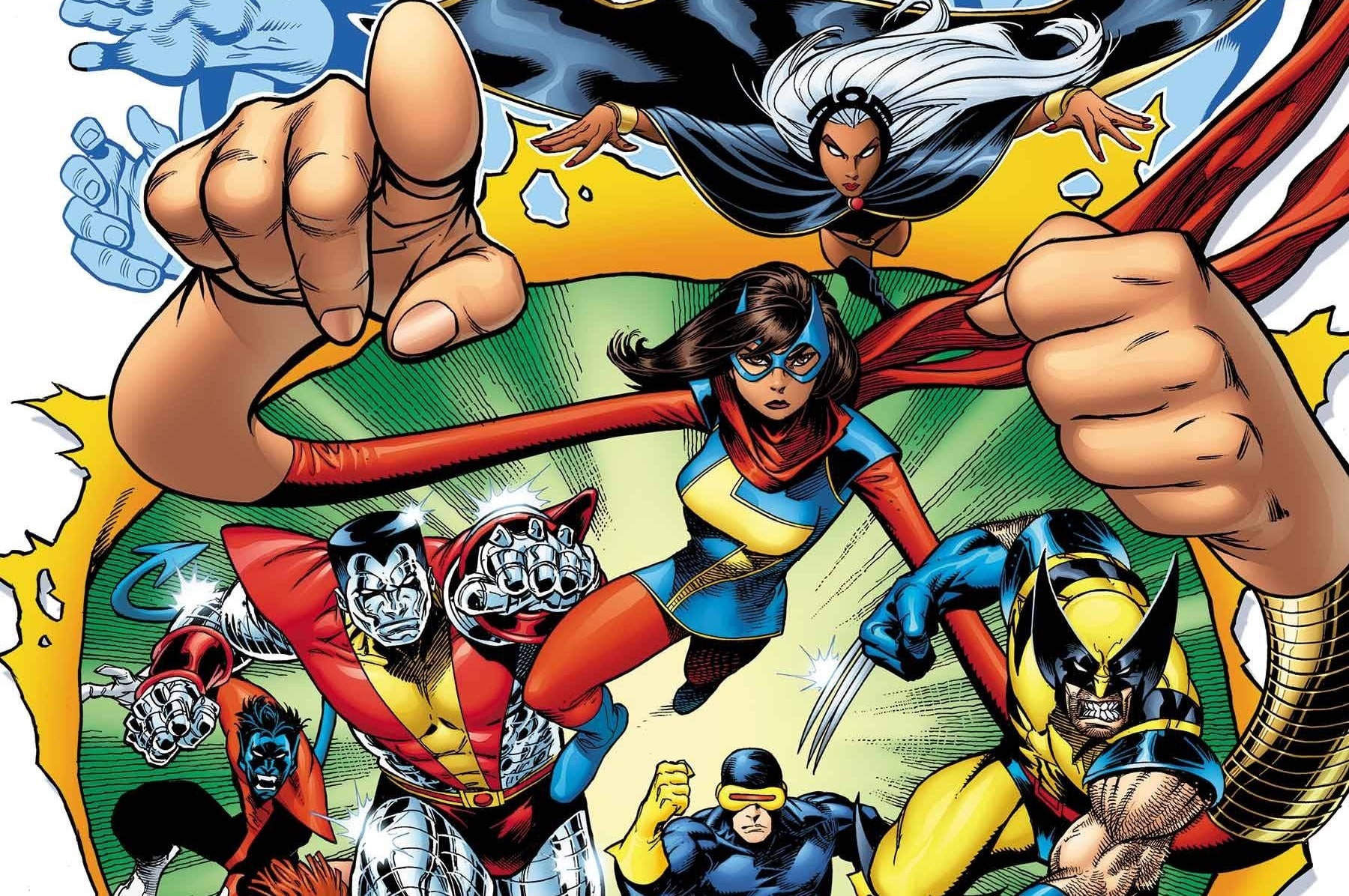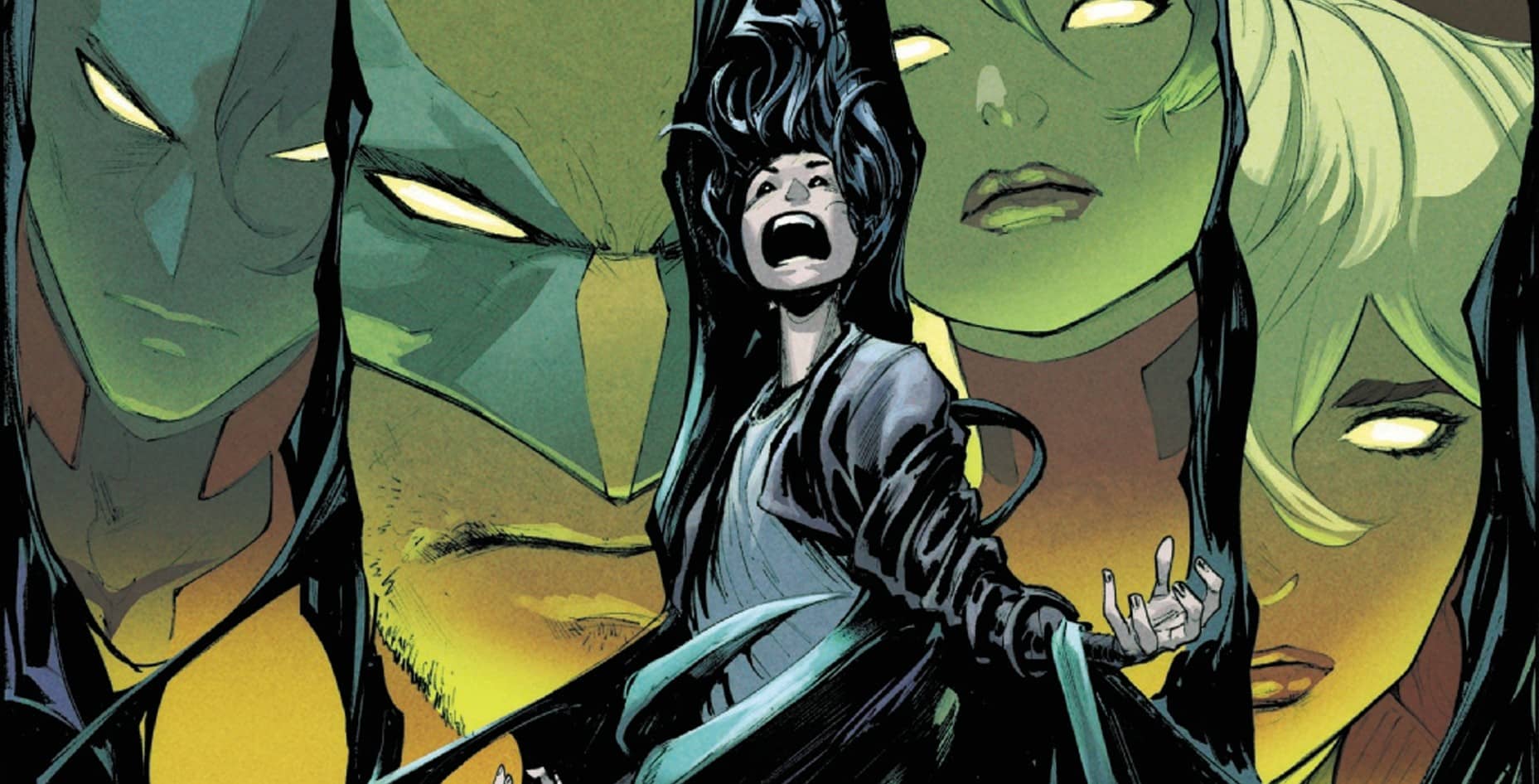In which the Comics XF team gathers to remember the things big and small that made the Krakoan era of X-Men comics an entertaining, transformative and memorable one. For more Krakoan remembrances, please read Jude Jones and Adam Reck‘s writing on the matter.
Sean Dillon
I suppose we should start with the beginning: HoXPoX was quite possibly the first time I ever felt excited to read an X-Men book month to month. Usually, I’d read their adventures long after the fact in trade, but the tantalizing premise and promise of the Karkoa era made me intrigued to follow where things ultimately went, from the many lives of Moira X to the chilling implications of those final pages. But perhaps the most underrated part was that it took the time to make jokes along the way. One of the things that so often keeps me from reading X-Books on a monthly basis is how self seriously they often take themselves. Sometimes, you just need a mutant whose ability is that he has a gun. Flagrant lying at its best.
Dan Grote
The First Krakoan Age was also the third Great Age of Wisdom. In Tini Howard and Marcus To’s Excalibur, Pete Wisdom played the role of the British-Krakoan team’s Dr. Valerie Cooper, doling out missions and running interference when things went pear-shaped. He also was one of the few mutants who wanted nothing to do with Krakoa, as a thing about Pete is he loves his country very much.
This sets up a fascinating B-plot for the character toward the end of Excalibur where, killed by Coven Akkaba in a blood sacrifice to resurrect Morgan Le Fay, Wisdom is resurrected in Arbor Magna and finds he can’t return to the UK because it has cut ties with Krakoa. We then get scenes of him looking miserable as mutants all around him laugh and dance in a home that still felt very new and exciting.
It is in this momentary depression that we see Peak Wisdom — the spymaster, the guy who stopped a vampire invasion from the moon — come back, as he concocts a plan to resurrect the members of 1980s Captain Britain supporting cast S.T.R.I.K.E. (who, it turns out, were all mutants, because…sure), and use them to take his country back from Coven Akkaba. That plan is abruptly halted in the final issue by Charles f$%&ing Xavier, who commandeers the whole operation as a matter of Krakoan security.
Pete’s big-damn-hero moment is delayed till the conclusion of 2023’s Betsy Braddock: Captain Britain, where, infiltrating Morgan Le Fay’s castle, he berserker rages on some Coven Akkaba goons, getting his long-sought vengeance, though admittedly, through (less satisfying) brute force rather than cleverness.
My favorite character is a sleazy John Constantine knockoff created by a sex pest whose best-known arc involves him dating someone previously believed to be a teenager. It’s not a good look, yet Howard, like Paul Cornell before her, saw the good in the character — the career spy who believes in his government despite its flaws, who can be slimy but also regularly gets hoisted by his own petard, but who also also can be a brilliant strategist and ally. One who, deep down, at the end of the day, knows when a job needs doing. I’ll always be grateful that my boy got his shine during this era, and I’ll keep my fingers crossed for what happens next.
Adam Reck
Hey – remember when Hickman/Howard/Larraz and Gracia landed the freakin’ SWORD station onto Saturnyne’s Otherworld hub and Jean led the X-Men into the final battle against Genesis and the demon hordes in X of Swords: Destruction?!? I do. It was the first time I had ever stood up and cheered at a comic book. And I mean this literally. I stopped reading, stood up and shouted something like YEAH!
For some folks, Captain America picking up Thor’s hammer in Avengers Endgame was this moment. But for me, I yearn for this kind of thrill in the funny pages. THIS is what superhero comics can do when everyone is clicking, when a grand vision is paired with visionary art. There were other moments along the way that I enjoyed for different reasons, but this one still stands out as packing the most adrenaline.
Scott Redmond
Despite loving the X-Men since as far back as I can remember (I used to sneak into my parent’s room to read my mom’s X-comics), the Krakoan Age is probably the most invested and in love with the X-Men I’ve ever been. Picking up every single book, feeling giddy and ready to read them all ASAP month after month. One of the major reasons was the range.
There was the whole getting away from their oppressors, building a society, and other beats that I appreciate greatly (especially at this point in my life, with eyes open wider than ever). But the range really stands out. By that I mean not just the different voices brought to play in the sandbox but the titles and characters that lived in them. Stalwarts like X-Men, X-Force, New Mutants, and Wolverine were there but we also got Hellions, Marauders, X-Terminators, Knights of X, Children of the Atom, SWORD, Sabretooth, and more. Amongst them were other stalwarts like X-Factor or Excalibur or X-Men Red given whole new leases on life and flavors.

Of those different flavors, if I had to pick something to highlight, it would be two titles on opposite sides of a coin, sort of. Hellions wrapped me from the word go. A series that looked at how those that are broken, outcast, wrapped in darkness, fit into a so-called paradise. It was one of the first titles to really start to poke holes in the Krakoan system, that still was employing methods of punishment and control similar to the world they left behind. This series took characters that we should not want to even glance at and made them empathetic, funny, relatable, and came with heartbreak.
On the other side was X-Factor. In one sense, they were kind of like the ‘law’ side of things, but not. Instead, the series dove deeper into the resurrection angle, and asked questions that the other books could not or would not. It was the book which actually gave us a good slice-of-life view of what things were like on Krakoa for those not on the council or who weren’t the usual standard favorite mutants (a great companion in this way to Vita Ayala & Rod Reis’ New Mutants run). X-Factor took the detective concept that the series had grabbed onto in the 2000s, and gave it a new shine. It also had numerous queer characters in the cast which was just delightful to see.

This is what comics should be, a flavor for everyone (if they are willing to try). Not just trying to capture the same nostalgic tones and ideas that passed decades ago.
Robert Secundus
HoXPoX itself is likely my second-favorite comic of all time (after Ostrander/Mandrake The Spectre). “Dawn of X” is likely my favorite line of comics of all time. “X of Swords,” my favorite event (with “Judgment Day” another major contender). Hellions, X-Factor, New Mutants, X-Terminators, Sabretooth, SWORD, and X-Men Red are all in the discussion of top 10 marvel comics I’ve enjoyed. People may roll their eyes at this kind of wild fanboyism, but it’s true: this is the single segment of superhero comics that has spoken to me above all others, with only Claremont-Era X-Comics coming close.
Still, my fondness, like many readers, lies primarily with the Hickman-lead Era, not necessarily because his work was my favorite of the line, but because after his departure the line began to feel at once rushed and decompressed, racing through molasses to a finish line that might appear at any time. I think the general wisdom going forward will be “HoXPoX through Inferno is the best stuff” (though I personally would extend the line to “Judgment Day” at least), but that means we’re already in danger of forgetting some major artistic accomplishments in the back half of this work. X-Force and Wolverine told longform stories the likes of which are very rare today in superhero comics, while also tackling the complexity of Krakoa’s problems in a way rarely achieved outside those titles. Even after the final Hellfire Gala, Jean Grey, Invincible Iron Man, Dead X-Men, and the Wedding Special all showed glimmers (to me, at least) of “Dawn of X”’s creative drive. Rise of the Powers of X and X-Men Forever recaptured some of the joys of HoXPoX; even if the braided structure of the finales somewhat faltered, X-Men #35/Uncanny X-Men #700 was a shockingly satisfying capstone to the era. I have significant issues with that issue, but still, given everything, I think it exceeded the expectations of many.

And so, as a gesture towards the diamonds in the rough, and the value of these comics beyond Hickman’s departure, I nominate The Resurrection of Magneto as a whole, but especially the final page, as Max, or Erik, or Magnus, steps into the future as Le Monde Magneto, the Fool of the Tarot completing the journey not in death, but in rebirth, fulfilled, triumphant, enlightened, transcendent. Even when shared universe serials falter, the form itself allows for incredibly powerful storytelling; all the misses of “Fall of X” were worth it for this moment and this miniseries.
Jake Murray
What made this era so special to me is that in addition to the huge-scale, high-concept sci-fi and fantasy storytelling of HoXPoX, “X of Swords” and Inferno gave us, there was a strong thematic focus on community. Putting aside the political wranglings of the Quiet Council and the high stakes battleship game of Krakoan international relations, for the average mutant citizen this was a first chance at creating a community from a position of safety. The title that told these stories moist poignantly was New Mutants, and in particular, Vita Ayala and Rod Reis’ run together.
By calling the New Mutants’ home on Krakoa the Sextant back in the first issue, Hickman establishes the perfect metaphor for the hope that characterized the “Dawn of X.” An instrument that measures the distance between the object and the horizon for celestial navigation purposes, it symbolizes mutantkind’s autonomy to chart their own course. Dani Moonstar and Sunspot’s conversation is so full of hope, full of belief and acknowledgement of the awesome responsibility they now have at shaping a community for the mutant youth, free of the ideological constraints of human societal norms. The possibilities at this stage felt limitless. Although not every seed sown bloomed, many did, and for that, I’ll be eternally grateful.
Vita Ayala’s time writing the series remained focus on this journey beyond the horizon while remaining realistic about the challenges that minority communities face. The central premise of their run was that in the face of predation from figures like the Shadow King, or the trauma of your past, the individual is not enough. Strength comes from forming a circuit, which came to be the symbol of mutant community to me. What I loved though was that there were no easy solutions given. It took work. It took training, it took listening to the guidance of the generation who came before. It took courage.
New Mutants, alongside the other “Dawn of X” titles, set us on a course for greatness. I’ll never forget the buzz of excitement from creators and readers alike. By the time we reached the tower on the horizon, it had changed inexorably, patched together by shoddy handiwork. Or maybe it just looked different up close. That’s ok, best laid plans and all that.
I’m just glad we made the journey.
Latonya “Penn” Pennington
New Mutants was a superhero team I’d become a fan of when I read Zeb Wells’ horror tinged New Mutants run back in 2018. I enjoyed seeing a team of young adults trying to reconcile their past and present while nurturing the next generation.
Yet, I hadn’t cared much for the Krakoa iteration of the series until Vita Ayala took over. Ayala’s run felt like the New Mutants I’d fallen in love with, but with an intricate mix of tough conversations, fun interactions, and poignant character arcs.
One notable moment involved a trans allegory being used in a conversation with Gabby and Anole. Anole defends his and Cosmar’s involvement with the Shadow King, who manipulates them with the promise of new bodies. Anole angrily says, “You don’t get what it’s like! Having your body make people recoil when they see you or look at you with pity — even here! No buts — not when you can pass for a human girl. Not that we want to be human, but maybe we want to be beautiful. And that isn’t immoral.”
Yet my absolute favorite arc in Ayala’s run is the “Labors of Magik” arc involving Illyana Rasputin aka Magik. As someone who has loved and related to the character since 2018 and as a survivor of various emotional traumas, seeing Illyana confront her past and possible future and emerge anew was beautiful to me. It made me feel like I could reclaim my joy and innocence as an adult and even partly inspired my poem, “Illyana Rasputin Teaches Me Creation Magic.” It gave me hope while I was trying to emerge from a deep, numbing depression and I am forever grateful.
Austin Gorton
My Top 10 Krakoa moments in rough chronological order:
1. The Many Lives of Moira X – House of X #2

A complete recontextualization of X-Men history in one issue. Xavier’s wide, surprised eyes are our eyes.
2. Doug’s wife – Cable #7

I love the way Krakoa elevated Doug Ramsey and strengthened the Summers family unit. But also, I love Jean’s facial response to “Doug’s large wife”.
3. Nanny gutting Sinister – Hellions #12

Hellions, one of a handful of series to really dig into a specific piece of the Krakoa setup (specifically, the question of what to do with the more villainous mutants granted amnesty), was a darkly comic romp driven by some great character work. It also made stars out of late 80s also-rans (and personal favorites) Nanny and the Orphan Maker, and for that, I will forever be grateful.
4. Terraforming Mars – Planet Size X-Men

More or less the zenith of mutant power during the Krakoa Era, the first Hellfire Gala concluding with the terraforming of Mars is a tremendous flex, and it opens the door for the tremendous X-Men Red.
5. Moira takes Banshee’s face…off – X Deaths of Wolverine #4

I still do not like Moira’s extreme heel turn into an evil robot, but having her pull a face-off with Banshee’s face to sneak back onto Krakoa is still one of the “holy shit” moments that will stick with me.
Magneto’s Last Stand – X-Men Red #5

Shortly after removing himself from the resurrection protocols, Magneto takes on Uranos in defense of Arakko, and after having his heart ripped out (literally), rises back up, using his power to keep his blood pumping. You go, my guy!
The Many Deaths of Mister Sinister – Immortal X-Men #9

Like Hellions, Immortal X-Men had a dark comic streak to it (and also dug deep into a specific facet of Krakoan culture), perhaps never moreso than in the sequence featuring Mister Sinister’s efforts to setup the “Sins of Sinister” timeline that results in an escalating series of Looney Tunes-esque deaths for the character.
Mystique and Destiny – X-Men Blue: Origins

All other far more important elements of it aside, the X-Men history nerd in me will never forget that it was during Krakoa that Chris Claremont’s intentions for Mystique and Destiny to be Nightcrawler’s parents finally went from “oblique hints sprinkled in random places that, if you know, you know” to established, on-page, canonical lore.
The Other Dominions Peace Out On Enigma – Rise of the Powers of X #5

Enigma facing off against Phoenix with all the other Dominions at his back, only for the other Dominions to tell him, “no thanks, you’re on your own” was the perfect capstone to all the work Kieron Gillen did to make Mister Sinister the defining character of his X-Men work.
Krakoa Says Goodbye – X-Men (vol. 6) #35

I am one of those bad critics who feels like I lack the necessary vocabulary to intelligently critique art and as a result tend to downplay it in favor of other elements in my writing, so I once again find myself struggling to explain why, but there’s just something about the final image of Krakoa saying goodbye to the mutants staying behind on Earth to be churned up into the latest relaunch that I find achingly beautiful. There are few words on the page, yet it seems to say so much. It haunts me (in a good way).
On a more personal note, I will always remember Krakoa as the era which brought me to ComicsXF, and introduced me to all the awesome people therein. I will always remember the Covid days, when we got to know one another while having no books to review. Coordinating coverage of “X of Swords” across all the different review teams, each with their own custom image banner. That time six of us (natch) got together and did an audio Sinister Six draft ahead of Spider-Man: No Way Home. Editing Jude Jones on X-Men Red and Resurrection of Magneto (not that he usually needed much editing), getting to read his terrific reviews before everyone else. Teaming up with Liz Large on Hellions and Mark Turetsky on Immortal X-Men. And so much more.
Reading comics and then writing about them are fundamentally solitary tasks, but the Krakoa Era made me realize they don’t have to be, and introduced me to the sheer joy that can be found with like-minded folks both collaborating on the work and simply shooting the shit over shared interests.
Stephanie Burt
Well, crap. I came to this tribute — this meeting of the Loud Council? this training for Mutant Circuits? — all ready to yell at the world about how the Vita Ayala/ Rod Reis run on Krakoa-era New Mutants had offered us not just my favorite Krakoa storylines — the Lost Club defying their teachers, the redemption of Amal Farouk, the renewed Dani/Xûan bond, Illyana’s abdication and transformation — but maybe the strongest character-driven stories since at least the Morrison run and maybe since the Claremont/Simonson era. I was all ready to go on about Xûan taking Dani to the Crucible, and about Cosmar’s trans allegory, and about Illyana completing the journey begun with the miniseries Magik and Storm (1984). But I’m late to the party. Penn and Jake already got there. Uh, they’re right? If you’re new to this material and you’ve read HoXPoX, read the Ayala New Mutants next. Then read it again. It’s the best.
And since Jake and Penn have pretty much already said so, I’m going to step away — but not very far away — from the Sextant and the teacher/ student dynamic and the lessons of Ayala and Reis (and Sienkiewicz and Claremont), far away from whole stories altogether, to give you a handful of favorite Other Krakoan Moments:
House of X 6, with the full-page displays of Krakoa’s new Home for All Mutants. The X-Men get a win, for once. And now comes the hard part: post-revolutionary state formation, and the creation of something like civil society in what had felt like a forever besieged underground.

New Mutants (2019) #1-2, in which HoXPoX arXitect Jonathan Hickman engineers Roberto’s departure from Krakoa and Earth to join his very bestest friend Sam and Sam’s partner Izzy Kane in what appears to be a Shi’ar homeworld counterpart to the famous house (with linked bedroom doors) on the moon. Truly these New Mutants are at last living their best lives. And thanks to the doors, they can go home whenever they choose.
Marauders (2019) #11-12: Kate Pryde comes back from the dead, calls Kurt her rabbi, and kisses a girl (who looks just like her ex-roommate), with Stefano Casselli and Matteo Lolli drawing a Red Queen who looks right for our Red Queen. Also we see how well the White Queen knows her. “Kate doesn’t smash barriers. She ignores them.”

Jordan White’s ukelele. Did you know he made at least psychic manipulation, get the knife out.
Amazing Baby, as first seen in Excalibur (2019) #8. Mommy? Daddy? Nonbinary parent or caregiver? Can we take home a warwolf too? They’re so cute. And shiny. And they have beaks. TV Tropes is on it.

Sabretooth (2022) #1-5, and especially #4, narrated by Third Eye. Does the ideal society need prisons? If not, what to do with somebody like Sabretooth? How you answer those questions — and what you think of prison abolition — is gonna depend on your own background, and on your own experience of the law. Also Leonard Kirk’s pencils rule.
The pages from Uncanny X-Men #700 in which Kafka explains to the A-list heroes that Krakoa will do just fine, thank you, once the next generation can run the place, and once it’s established far, far away from superheroes and supervillains and violent real-world politics, in a space where nobody (in-universe or at Disney) demands a fight. I was afraid the era would end with yet another genocide; instead, the Utopians just nope out on a Marvel-run, warlike Earth that adults have already ruined. Anyone else end up reminded of Earthseed?
New Mutants: Lethal Legion #1-5. In which Escapade — an on-page trans mutant whose transness isn’t just trauma, but whose powers say something about her identity —ends up leading a slightly ridiculous, wholly delightful, caper: a 1970s Marvel what-the-heck plot against a 1960s supervillain, a large cast of mostly young characters handled deftly, and a now levelled-up Enid Balàm showing that she’s the right artist for a caper book. Balàm and Charlie Jane Anders, Escapade’s creator, would both get more work from Marvel in a just world. But in a just world, Krakoa could stick around.
X-Men (2019) #7. Of course the Crucible. Melody gets her powers back. Autonomy comes at a price. Apocalypse loves violence but he also wants to make mutants fierce. “Jeannie in a bikini.” “Scott in a Speedo.” “Another day in Paradise.” Who said the only true Paradises get lost?
Anna Peppard
I wasn’t as immediately cuckoo for Krakoa as some of my friends and co-writers here. Because I read HOXPOX a few months after it wrapped, at a time when I’d been on a multi-year break from X-comics, the shock and awe of its big reveals were a bit lost on me. Mostly, I thought it was an interesting (and beautifully illustrated) story. But I had doubts about the sustainability of the worldbuilding and thought some notable characters would need to be written out-of-character in order for this new status quo to feel believable. While I think some of those critiques might have been valid, what eventually sold me on the era was the fan community surrounding it. The passion people had for this era transformed it, for me, into something transformative. It also contributes to the nature of my remembrance of one of my fondest Krakoa issues.

Immortal X-Men #7 was a Judgment Day tie-in starring my guy Nightcrawler. Up to that point, I hadn’t been thrilled with my fave’s involvement in the new era (that’s putting it mildly, but let’s not rub salt in old wounds). But as a confirmed fan of writer Kieron Gillen, I’d been looking forward to this issue. And it did not disappoint. Here’s some of what I wrote about it at the time:
“In this comic, as in my heart, Kurt Wagner is a character centrally defined by goodness and hope, but that goodness and hope isn’t naïve, simplistic or silly. It is hard-fought, reckless and deeply heroic. This is a comic book in which Kurt sacrifices his life at least seven times in quick succession, via live backups that mean he feels and remembers the pain of being repeatedly incinerated, for the sake of laying a single fingertip on Nimrod, which is all he needs to save the world (for a while, maybe). And of course he looks fabulous doing it. In the panel in question, he’s posed as either God or Adam from Michelangelo’s ‘Creation of Adam’ fresco, but upside down with swoopy hair and a devil’s tail. Apocalyptic stakes can’t stop a flamboyant mutant swashbuckler from swashbuckling. If anything, it makes him swashbuckle harder.”
But just as memorable as the issue itself is the experience of reading the early review copy in real-time alongside my friends. I think Mark Turetsky got to it first, and said he thought I’d probably enjoy it. I scrolled through that PDF in something close to actual sweaty excitement, then screamed my joy all over our Slack.
It was a good day, made possible because of the community Krakoa grew.

